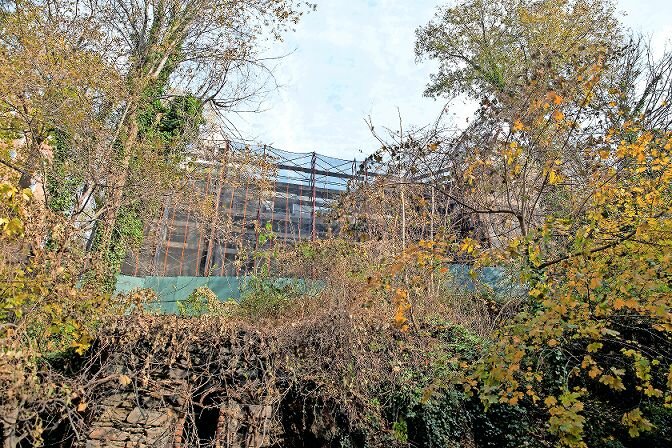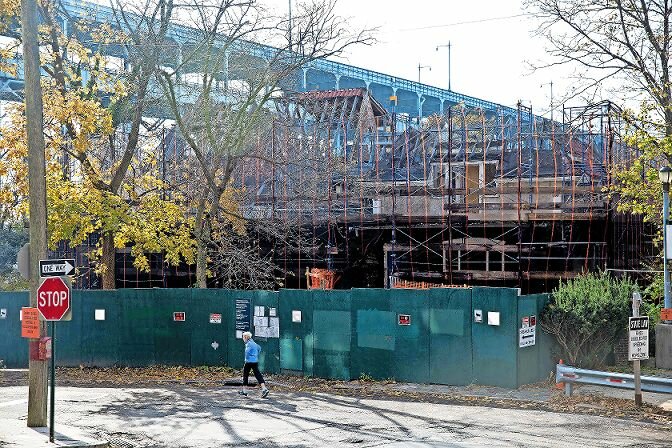Villa Rosa Bonheur — lost, but it’s not forgotten
Once advertised in the New York Times as something for anyone whose “soul is hungry for the river,” Villa Rosa Bonheur watched over the Harlem River for nearly a century.
But it was known for more than just its sweeping views. The architectural marvel adorned with a terracotta roof and clad in stucco, was considered a crown jewel of the Bronx. One of the first examples of a multi-family house in the borough, the seven-unit co-op stood as a symbol of a bygone era.
For decades, Villa Rosa Bonheur stood on a cliffside in Spuytin Duyvil with its “sisters,” the Villa Charlotte Brontë and Villa Victoria. Now just the sisters remain, and a high-rise tower stands in Rosa’s place.
Last week, more than a dozen community members joined the Kingsbridge Historical Society in paying homage to the lost neighborhood gem. At the historic Edgehill Church, all eyes were on Stephanie Coggins. A devoted member of the historical society, she was a vocal activist in the fight to stop the Villa Rosa Bonheur demolition. Although that battle was lost, she remains committed to keeping the beloved landmark’s legacy alive.
With the help of a PowerPoint presentation, Coggins detailed Rosa’s architectural and historical significance.
“Exceedingly unique from any other homes of its kind in New York City,” she said. “Every commuter descending the fieldstone and winding staircase or driving by in a Rail Link Bus gazed upon her charming exterior.”
As Coggins described Rosa’s controversial demise, the church room’s atmosphere grew somber. She recalled the years-long fight by residents and various activist groups to halt the destruction of the home, a movement sparked by the removal of the iconic terracotta roofing.
Despite devoting countless hours to a grassroots campaign, protestors ultimately failed to save the Villa from demolition.
Built in 1924 by John J. McKelvey Sr., founder of the Harvard Law Review, the property was an intimate escape from the hustle and bustle of the growing city.
Beatlemania creator Robert Rabinowitz later purchased the villa, and it stayed under his ownership until his death in 2016.
The following year, the villa was sold to Manhattan-based developer Timber Equities for $2.6 million, a move that would seal Rosa’s fate.
In early 2018, the city buildings department issued the interior demolition permits needed to renovate the villa’s existing seven units into 11 on the condition there would be no structural changes.
By August, it became apparent to neighbors what they were seeing was far from an interior renovation. They watched as construction workers chipped away at the terracotta roof. The exterior walls came down soon after.
“The expensive tiles were being ripped from the roof, thrown to the ground, and destroyed,” Coggins said, holding up a cherished relic. “This is one of the Spanish tiles that was raining from above. I managed to save one of them.”
Later that month, the building department hit Timber Equities with the first of many stop-work orders, citing “work not conforming to permits.”
Public concerns escalated to a desperate outcry in the fall of 2018. Like most buildings erected before the 1980s, construction materials used to build Villa Rosa Bonheur were lousy with asbestos, exposure to which poses significant health threats, including an elevated risk of lung cancer and other pulmonary diseases.
“Neighbors were concerned about the future of the building, safety issues, and potential asbestos exposure to the community,” Coggins said in her presentation.
In November 2018, another stop-work order was issued. Timber Equities had failed to conduct any asbestos abatement on the property before starting construction. With the fear of exposure confirmed, the community mounted an even stronger unified resistance.
By the end of that year, at least three other stop-work orders would be issued for unsafe scaffolding and a lack of workers’ compensation.
Over the next two years, the battle between Timber Equities and residents, community board members and elected officials intensified. As the villa was gradually reduced to rubble, construction fencing around the site displayed graffiti like “Shame” and “Restore Me.”
But the community’s pleas to the city fell on deaf ears. It soon became clear the original promise of an 11-unit conversion was not the truth. New permits issued by the building department allowed for a total demolition of the villa to make way for a luxury 55-unit apartment building instead.
“It was like a stab in the heart,” Perry Brass, a member of the historical society, said.
The project came to fruition in 2021, about four years after the villa’s purchase. During that period, the city issued Timber Equities at least 20 violations.
Although Coggins and the rest of the Kingsbridge Historical Society were unsuccessful in their pursuit to save Villa Rosa Bonheur, they remain dedicated to memorializing the exquisite landmark.
Coggin’s latest tribute was her successful effort to co-name the street where Rosa once stood. In 2022, the Palisade Avenue street sign was joined by one reading John J. McKelvey Sr. Villa Rosa Bonheur Way.
“Both Villa Rosa Bonheur and her creator, John J. McKelvey, were responsible for so much of the beauty and character of our unique community,” Coggins said. “They were both worthy of the honor of this historic acknowledgment.”











